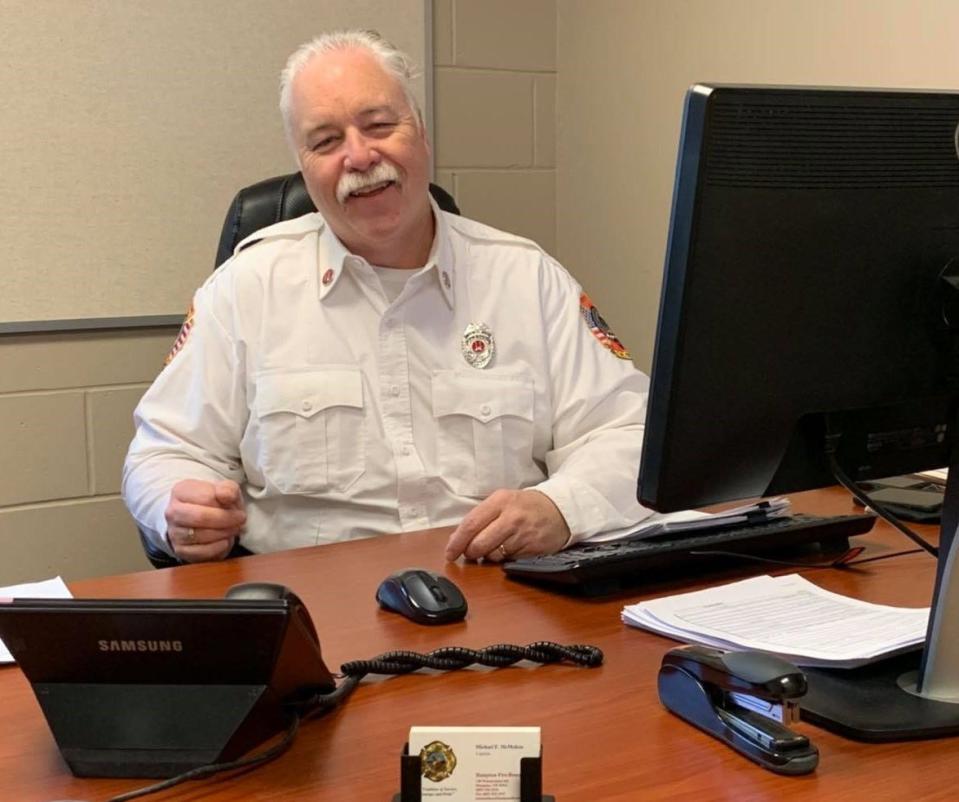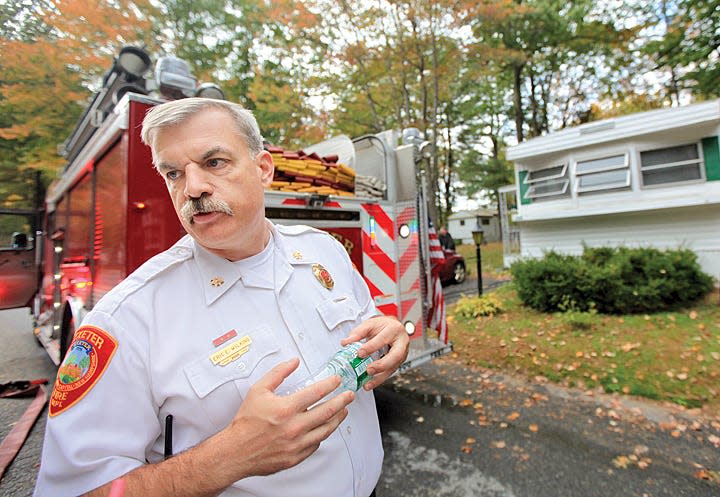'Silver Wave': How New Hampshire’s aging population is straining Seacoast fire departments
New Hampshire’s population is getting older, and the “Silver Wave” is having an impact on emergency services and town budgets.
New Hampshire has the second oldest population in the nation, with a median age of 43 years old, according to World Population Review. Only neighboring Maine has an older population, and Florida, known for its retirement communities, is behind New Hampshire with a median age of 42.
Maine and New Hampshire aren’t unique in the Northeast. Every New England state is among the 15 oldest in the nation.

But median age doesn’t tell the whole story. According to estimates from the U.S. Census, in 2023, New Hampshire had about 1,395,000 people, with more than 20 percent over 65.
In Seacoast communities, median age levels are even higher than the state average. One reason could be that coastal real estate is usually priced beyond the wallets of young families, often selling to older adults in their high-earning years or to those moving here to retire.
Another reason could be the tendency of local planning boards to welcome 55-plus residential subdivisions while frowning on those that foster young families in hopes of not increasing student populations. The belief was fewer students would keep school budgets from rising, and that older adults had minimal impact on town services.
However, Seacoast fire chiefs say those theories are proving incorrect. Just as the opioid epidemic drove up law enforcement costs, the region’s fire chiefs say that the large proportion of older residents here is driving up demand for emergency medical services and their budgets.
When it comes to municipal expenses, for most Seacoast communities, fire departments with their rescue services rank number one in cost. Hampton, with its high-traffic summer tourist season, is an exception, with the Police Department coming in with the largest portion of the town budget. Hampton Fire Department ranks second.
Hampton salaries: 42 town employees earned $100,000 or more in 2023
Seacoast fire departments shift historic roles
In days gone by, firefighters fought fires, responded to traffic accidents, and were the ones to call to get cats out of trees, according to Hampton Fire Chief Mike McMahon. They still are, he said, but standardized fire and safety codes have produced safer structures, and fighting fires is no longer the major focus of fire personnel.
In the 1960s and 70s, McMahon said firefighters began training as emergency medical technicians and paramedics to handle human trauma in the field more successfully. The trend spread throughout the country, he said, with Hampton establishing its ambulance service in 1973.

Today, every firefighter in a fire station is expected to be a certified EMT or paramedic, McMahon said, and they spend most of their energies providing medical assistance.
“There’s been a shift,” McMahon said. “In general, calls for service are rising, and most of those calls are medical.”
McMahon attributes a good portion of that to New Hampshire’s older citizens calling 911 for medical assistance often, and other chiefs agree.

In a 2021 interview, Exeter Fire Chief Eric Wilking saw a shift from fire to medical services in most community fire departments. In Exeter, he said, calls for service in 2021 rose to about 4,000, while five years earlier, there was about 1,800.
“Seventy percent of our calls are medical these days,” Wilking said at the time. “Twenty, 30 years ago, if you broke something or cut your finger badly, you got yourself to the hospital. Today, you call 911, and the ambulance responds with two or three people in it. We see a lot of non-emergency medical calls, but we respond to everyone.”
More: Epping overruled again by NH Housing Board, paving way for 315-unit apartment complex
Seacoast has older population than state average
Hampton’s demographics reinforce McMahon’s experience. According to the state Department of Employment Security, Hampton’s 2022 estimated population is 16,484. The median age is 51.5 years, about 42 percent or about 7,100 over the age of 55, of which 4,000 are 65 and older.
Exeter’s demographics are similar to Hampton, according to NHES, with a 2022 population of 16,178 and about 5,715 (or 35%) 55 and older, with a median age of 46.6.
About half the size of Hampton and Exeter, according to the Department of Employment Security, Seabrook’s 2022 population is estimated at 8,438, with a median age of almost 51 years old. It records nearly 3,700, or about 44 percent of its population as 55 or older. Those 65-plus (2,288 or 27%) translate to the largest segment of Seabrook’s residents.
Seabrook is also witnessing an increase in service calls, according to Seabrook Fire Chief Bill Edwards. It went from 2,628 total calls (1,176 ambulance calls) in 2017 to 3,317 total calls in 2021 (1,433 for ambulance services). As of mid-December 2023, Edwards said Seabrook Fire Department took 3,554 service calls, including 1,993 medical, the majority for individuals 65 and older.
Even in one of the smallest towns on the Seacoast, Hampton Falls Fire Chief Jay Lord reported requests for medical help are the most common his department receives.
Lord attributes much of that to the “Silver Wave,” the aging of the now-retired “Baby Boom” generation.
Born from 1946-1964 during the post-World War II population expansion, the Baby Boomers' needs and views dominated American marketing, political and societal trends. These days, Boomers’ impact is still felt in the demand for medical services, according to Lord.
“The Silver Wave makes more medical calls,” Lord said. “And the Silver Wave is crashing on the beaches.”
Hampton Falls’ population is tiny, only 2,411, and its median residents’ age is 47.8. More than 840, or about 35%, are 55-plus. Interestingly, only 43 residents are under the age of 5.
According to Lord, even in a small town with limited resources, the law stipulates firefighters/EMTs must go to all 911-type calls. Whether they come from a Hampton Falls resident who calls frequently or an out-of-state motorist on I-95, Lord said New Hampshire emergency responders must respond.
In North Hampton, where the median age of the 4,553 residents is nearly 50, according to the 2022 U.S. Census, 1,746 are 55 or older, with 1,010 aged 65-plus. Again, only 43 are under 5 years old.
According to North Hampton Fire Chief Jason Lajoie, calls for medical services are rising. Firefighters/EMTs aren’t just putting bandages on cuts, he said, they are providing sophisticated, lifesaving procedures – treating and stabilizing trauma victims, and restarting hearts – all of which require skill, continual training, and expensive medical equipment and supplies.
“When people dial 911, they expect us to respond and to be able to help them,” Lajoie said.
But the national and statewide shortage of people willing to assume the dangerous and often life-and-death roles of first responders is jeopardizing that expectation, Lajoie said, as well as driving up the cost of delivering those services.
For several years, communities have had difficulty filling police and firefighter/EMT positions. As that labor pool shrinks, competition for qualified candidates has increased. Even entry-level salaries are rising so departments can fill vacancies. If not, towns take the chance of losing candidates to other agencies.
Goats, yoga and wine: Why Stratham farm's Wine-yasa session is a baa-rilliant idea
Hikes in calls for service impact town budgets
Unlike corporate America, which can charge more when demand for a product is high, first responders can’t.
Borne by taxpayers, the financial cost of having police and firefighter/EMTs available when emergencies arise is considered a critical part of a community’s sense of security and a quality of life issue for most.
Local fire departments can and do bill for transporting patients by ambulance to hospitals. But other than that, fire departments aren’t allowed to bill for medical services or supplies they use, according to Lord.
“If the patient refuses to be transported to the hospital,” Lord said, “we aren’t allowed to bill.”
Ambulance transport charges are primarily paid by insurance companies, Medicare and Medicaid at set rates, McMahon said, adding they “don’t chase” individuals if they don’t pay.
“Whatever the insurance company or Medicare/Medicaid give us, we take,” McMahon said. “We don’t balance bill.”
The Brook casino: Company rolls dice on housing complex project with NH Housing Appeals Board
Silver wave may turn into ‘silver tsunami’
Granite State demographics don’t appear to be reversing themselves anytime soon, but locally things could be getting even grayer. Rockingham County – NH’s second largest – exceeds the state’s aging trend. The pattern caused the Rockingham Planning Commission to project that “while from 2015 people aged 65+ made up about 16% of the population in Rockingham County, (by) 2035 older adults will make up over 28% of the population.”
The RPC may be optimistic. According to a Jan. 23 story by CBS News, the number of Americans retiring in 2024 will break records, “with an average of 11,000 Americans a day expected to celebrate their 65th birthday from now until December.”
“Approximately 4.1 million Americans are poised to turn 65 this year and every year through 2027, according to a report from the Alliance for Lifetime Income,” CBS News reported. “Dubbed by experts as ‘peak 65' or the ‘silver tsunami,’ the figure represents the largest surge of retirement-age Americans in history.”
This article originally appeared on Portsmouth Herald: How New Hampshire’s 'Silver Wave' is straining emergency services

